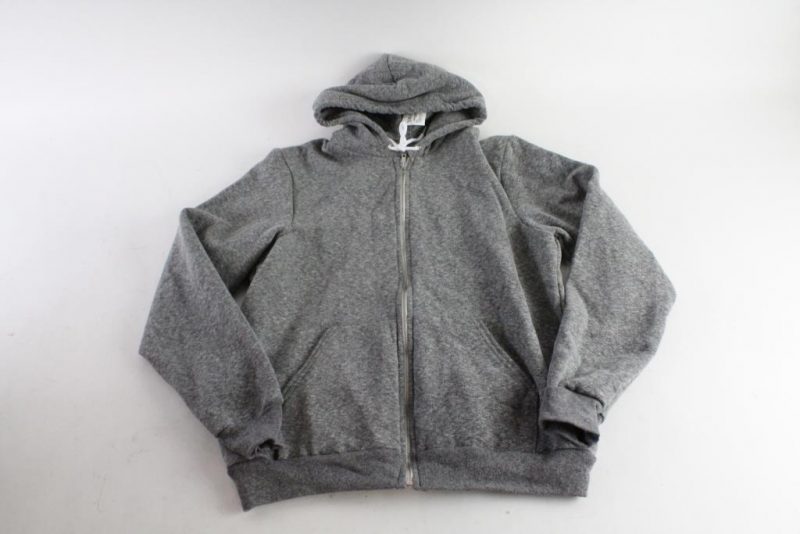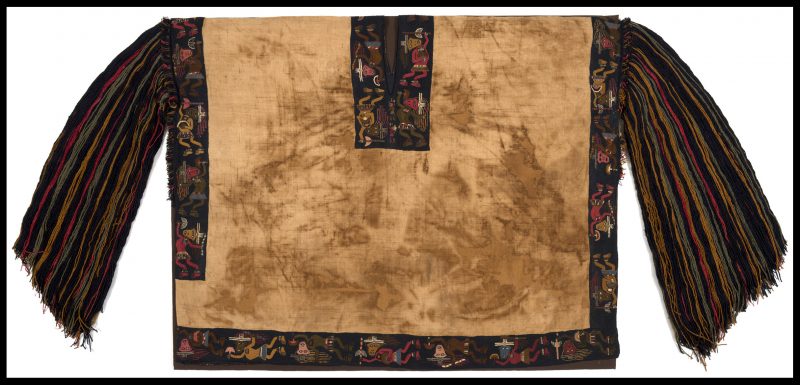Seven Generations of Clothing
Posted on October 26, 2018“We believe that every action that you make will have an effect for seven generations. If you are careless or cruel it will cause a scar of trauma that will last through the next seven generations as well. If you want to teach something, you must teach it in a way that would last for seven generations.” – Amelia Winger-Bearskin.
This passage has really resonated with me, and I keep thinking about what this means. Especially as it relates to redefining and intervening a system outside of the capitalist model. How do we embed meaningful values into our future worldings? [2] What would it look like for a garment to be passed down seven generations? What would a pair of my great-great grandmother’s boots from the mid 1800s look like, fit like, today? What would my American Apparel hoodie look like, fit like, on my great-great granddaughter in 3068?

American Apparel Zip-Up Hooded Sweatshirt, 2014.
Amelia Winger-Bearskin is a creative director, artist and VR specialist who describes herself as a “New York Native”. [1] She is of Haudenosaunee heritage, peoples that have inhabited New York for centuries. When I read this, it was the first time I had heard anything about New York City’s relationship to its Indigenous Peoples. I had been wondering about this since moving to New York and beginning school at Parsons School of Design. At the end of Intensive Week, we presented our project, and I have become accustomed to making a formal note at the beginning of presentations about which land we are on. In Vancouver, and across Canada it is becoming practice to formally address an audience. In 2014, Mayor Gregor Robertson announced Vancouver is on unceded territory, that the city has never been ceded through treaty, war or surrender. [3] There has been a considerate effort in Canada towards reconciliation for the cultural genocide that took place during colonization between 1500s-1800s, starting in the East and moving West. Since beginning my undergraduate degree in 2009, it wasn’t until my final years in 2015 and 2016 that this effort was more notable and more consistent at presentations, shows and events. I write this in part, to explain why it struck me, and why I’ve taken this on as a practice of my own to acknowledge the humans / non-humans that have come before me and that I am a guest on this land.
I have brought this idea of Seven Generations into all of my other classes: in DLR through the Wheel of Reason, in TD Seminar during a discussion about Irreducibility and the future of design, and posed it as a question to Anthony Dunne during his visit to Design Activism Projects Studio, in terms of how far out he looks when he’s designing. Mid-October, I visited the Brooklyn Museum to see Cecilia Vicuña’s Disappeared Quipu with fellow a fellow TD’er. During our time at the show, we took in textile artefacts in display cases, garments spanning 1400 years woven from the Nasca, Wari, Chimú, and Inca cultures [4]. And there too, I brought up this frame of thinking in relation to seven generations with this person, whom we had a 10 minute discussion about this in the dimly lit space of the museum, beside these ancient garments.

Wari Kayan 49, tunic of beige cotton with with polychrome plied shoulder fringe and narrow, dark purple borders depicting a horizontal version of the Falling Figure in a Block Color style, item 42, Registro Textil 1292. Museo Nacional de Antropología, Arqueología e Historia del Perú.
I’m continuing to use this as a lens to look through and question how does one inhabit this mindset shift and bring this into their practice? Or rather, how do I embrace / embody this mindset shift, is seven generations the appropriate amount of time to be considering, or is 5 generations more achievable? And, how do I bring this into my design practice?
NT
[1] Amelia Winger-Bearskin. Before Everyone Was Talking About Decentralization, Decentralization Was Talking to Everyone. Immerse News. July 2, 2018. Accessed Sept. 21st, (2018). https://immerse.news/decentralized-storytelling-d8450490b3ee
[2] Haraway, Donna. Anthropocene, Capitalocene, Plantationocene,
Chthulucene: Making Kin. Environmental Humanities, vol. 6, 2015, pp. 159-165. Accessed October 22nd (2018). http://environmentalhumanities.org/arch/vol6/6.7.pdf
[3] Meiszner, Peter. City of Vancouver Formally Declares City is on Unceded Aboriginal Territory. Global News. June 25, 2014. Accessed October 19th, (2018). https://globalnews.ca/news/1416321/city-of-vancouver-formally-declares-city-is-on-unceded-aborginal-territory/
[4] Vicuña, Cecilia. Disappeared Quipu. Brooklyn Museum. Accessed October 19th (2018). https://www.brooklynmuseum.org/opencollection/exhibitions/3359/
Images
https://www.coedmonkey.com/products/american-apparel-f497-hooded-sweatshirt